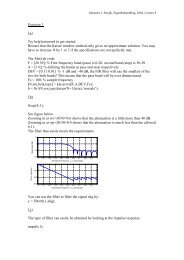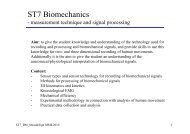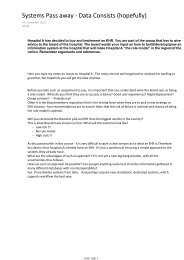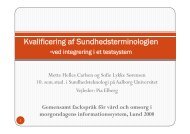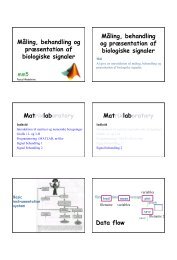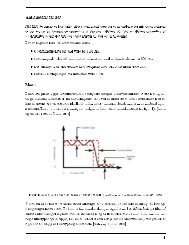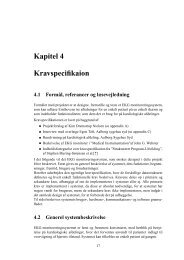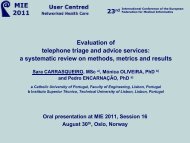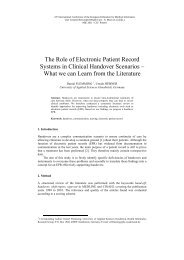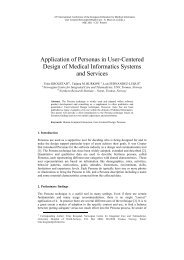Objectives
Objectives
Objectives
You also want an ePaper? Increase the reach of your titles
YUMPU automatically turns print PDFs into web optimized ePapers that Google loves.
© Uwe Kersting, 2008<br />
© Uwe Kersting, 2008<br />
GONIOMETRY and VIDEOGRAMMETRY<br />
in (Sports) Biomechanics<br />
<strong>Objectives</strong><br />
Center for Sensory-Motor Sensory Motor Interaction<br />
Anvendt Biomekanik<br />
Uwe Kersting – Lecture 03 - 2008<br />
• Basic working principles of goniometers<br />
• Considerations how to apply them<br />
• How to interpret data gained<br />
• Basic principles of photogrammetry<br />
• 2dimensional video technique<br />
• Discuss advantages and disadvantages<br />
• Apply both techniques in running (practice<br />
examples)<br />
© Uwe Kersting, 2008<br />
Contents<br />
1. From movement to data – a general<br />
concept<br />
2. Goniometry: techniques & limitations<br />
3. Goniometer application<br />
4. Fundamentals of photogrammetry<br />
5. Planar kinematics<br />
6. Summary<br />
1<br />
2<br />
3<br />
1
© Uwe Kersting, 2008<br />
© Uwe Kersting, 2008<br />
Biomechanics<br />
Da Vinci: Mechanics is the paradise of<br />
mathematical sciences because by<br />
means of it one comes to the fruits of<br />
mathematics. (1452 – 1519)<br />
Hatze (1971): Biomechanics is the science,<br />
which studies structures and functions<br />
of biological systems using knowledge<br />
and methods of mathematics.<br />
Newton’s laws etc.<br />
Biomechanics = Science of the<br />
effects of forces on human body<br />
system<br />
• Movements of segments of interest<br />
• Muscles as the actuators<br />
--------<br />
• Kinematics = movement of segments<br />
or total body<br />
• Kinetics = forces acting on segments<br />
or the total body<br />
© Uwe Kersting, 2008<br />
A sport biomechanist‘s job<br />
or one possible way to go<br />
• Description<br />
• Analysis<br />
• Interpretation<br />
• Suggest a change<br />
• Re-evaluate<br />
• Teach / train the changes if<br />
effective<br />
How?<br />
4<br />
5<br />
6<br />
2
© Uwe Kersting, 2008<br />
Sensor<br />
© Uwe Kersting, 2008<br />
© Uwe Kersting, 2008<br />
Goniometer essentials<br />
Goniometer:<br />
uniaxial<br />
‚parallax‘<br />
multiaxial<br />
digital, analog<br />
Measurement chain<br />
Amplifier AD converter Computer Storage medium<br />
SIGNAL<br />
The digital frontier<br />
Figure 1: Measurement chain.<br />
software<br />
printer<br />
monitor<br />
Goniometer essentials<br />
Fulcrum of goniometer = fulcrum of<br />
joint!<br />
REPORT<br />
REPORT<br />
7<br />
8<br />
9<br />
3
© Uwe Kersting, 2008<br />
© Uwe Kersting, 2008<br />
Rearfoot goniometer<br />
Jumps in athletics<br />
Planar motions? – fundamentals of modelling +<br />
biomechanical accessability<br />
L1: TAKEOFF<br />
DISTANCE<br />
TAKEOFF<br />
ACCURACY<br />
v<br />
© Uwe Kersting, 2008<br />
BODY<br />
POSITION<br />
Long jump analysis<br />
(i.e. partial distance model)<br />
TAKEOFF<br />
HEIGHT<br />
PHYSIQUE<br />
TAKEOFF<br />
SPEED<br />
DISTANCE<br />
L2: FLIGHT<br />
DISTANCE<br />
TAKEOFF<br />
ANGLE<br />
AIR<br />
RESISTANCE<br />
ACTIONS<br />
ON<br />
LANDING<br />
BODY<br />
POSITION<br />
L3: LANDING<br />
DISTANCE<br />
10<br />
11<br />
PHYSIQUE<br />
12<br />
4
v<br />
© Uwe Kersting, 2006<br />
Biomechanical analysis...<br />
© Uwe Kersting, 2008<br />
© Uwe Kersting, 2008<br />
© Uwe Kersting, 2008<br />
L1 L2 L3<br />
Technique analysis<br />
5<br />
We use models for<br />
- simplification<br />
- representation/mapping<br />
- reduction<br />
- subjectivation<br />
• Define phases of movement<br />
• Identify factors of importance<br />
• Identify criteria to assess techniques<br />
Historical perspective<br />
simple models<br />
Historical perspective<br />
Aristotle (384 - 322 B.C.)<br />
De Motu Animalum<br />
„If a man would walk in the sunshine in parallel<br />
to a wall the line, which his head describes<br />
would not move in a straight line. It would<br />
follow a zig-zag pattern; going down when he<br />
flexes and moving upwards when he<br />
straightens.“<br />
13<br />
14<br />
15<br />
5
© Uwe Kersting, 2008<br />
© Uwe Kersting, 2008<br />
Measure directly or use images?<br />
Pros and cons?<br />
Historical perspective<br />
Technical realisation:<br />
camera obscura<br />
Also described and<br />
used by Aristotle,<br />
Kepler<br />
First technical<br />
drawings by<br />
Leonardo DaVinci<br />
(1490)<br />
© Uwe Kersting, 2008<br />
b<br />
Improvements<br />
Optics of light beams, inclusion of lenses,<br />
photographic recording<br />
Focal length = „distance of lense centre to the<br />
location where incoming parallel beams cross“<br />
For a standard photo camera (24 * 36 mm): f = 50<br />
mm represents a ‘normal’ view<br />
16<br />
17<br />
18<br />
6
© Uwe Kersting, 2008<br />
© Uwe Kersting, 2008<br />
© Uwe Kersting, 2008<br />
Multiple exposure<br />
Eadweard Muybridge<br />
(1830 – 1904)<br />
Multiple exposure & viewpoints<br />
Central plane<br />
Object<br />
Image<br />
Central plane<br />
Object<br />
19<br />
20<br />
Image<br />
21<br />
7
© Uwe Kersting, 2008<br />
© Uwe Kersting, 2008<br />
© Uwe Kersting, 2008<br />
Caution! - on two levels<br />
‚Fish eye-effect‘<br />
Caution! - on two levels<br />
‚Waterfall-effect‘<br />
Lens correction<br />
Freeze!<br />
22<br />
23<br />
24<br />
8
Braune and Fischer<br />
(~ 1900)<br />
Scaling the on the<br />
imaging plane<br />
© Uwe Kersting, 2008<br />
© Uwe Kersting, 2008<br />
© Uwe Kersting, 2008<br />
Simpler approach<br />
is possible<br />
Examples of sports techniques<br />
Pole vault<br />
Example II, choice of perspective!<br />
25<br />
26<br />
27<br />
9
© Uwe Kersting, 2008<br />
Partial heights<br />
model<br />
(transferable<br />
to many<br />
movements)<br />
(Hay, 1978)<br />
© Uwe Kersting, 2008<br />
© Uwe Kersting, 2008<br />
Example III<br />
H<br />
Use a model<br />
Partial heights model: factors<br />
28<br />
29<br />
30<br />
10
© Uwe Kersting, 2008<br />
© Uwe Kersting, 2008<br />
Summary<br />
Aim of biomechanical investigation<br />
is to:<br />
describe movement and explain how<br />
it works<br />
reduce trial and error approaches<br />
in coaching and teaching.<br />
There are obvious limitations<br />
There are big advantages<br />
Optics<br />
How to measure the size of an object on an image?<br />
© Uwe Kersting, 2008<br />
Calibration for 2D<br />
Reference measurement (calibration)<br />
If the movement plane is parallel to the<br />
imaging plane a distance measure is<br />
sufficient to calibrate the set-up.<br />
If the movement plane is aligned<br />
obliquely we need a 4-point<br />
calibration. Common digitisation<br />
software includes this option.<br />
31<br />
32<br />
33<br />
11
Limitation of 2D<br />
analyses to planar<br />
motion and correct<br />
camera positioning<br />
...?...<br />
© Uwe Kersting, 2008<br />
Alignment<br />
Example: Track and Field - Side view<br />
Camera on the stands<br />
© Uwe Kersting, 2008<br />
© Uwe Kersting, 2008<br />
e<br />
γ<br />
τ<br />
δ + τ = β<br />
δ<br />
Track<br />
34<br />
35<br />
36<br />
12
© Uwe Kersting, 2008<br />
Cinematography<br />
24 images per second<br />
(std.)<br />
Low cam – 800 images<br />
per second<br />
Mechanical shutter<br />
1/10 000 s<br />
- lighting!<br />
‘by hand’ digitisation<br />
© Uwe Kersting, 2008<br />
Limitation:<br />
25 or 50 Hz<br />
time<br />
resolution<br />
© Uwe Kersting, 2008<br />
Video technique<br />
Image construction out of lines<br />
Camera chip<br />
digital<br />
Video<br />
Video technique<br />
Digitisation; frame grabber board<br />
1<br />
2<br />
3<br />
4<br />
5<br />
6 .<br />
7 .<br />
12 3 4 5 6 7 . . .<br />
Video image<br />
analog<br />
Video<br />
37<br />
38<br />
39<br />
13
© Uwe Kersting, 2008<br />
Recording on tape<br />
Video resolutions: in time: 50/60 Hz<br />
180 – 600 lines<br />
Electronic shutters<br />
Frame grabber boards<br />
< 512 * < 512<br />
Digital cameras – recording to tape or disk<br />
‚Megapixel‘ Images<br />
1024 * 1024<br />
Vicon MX = 4 Mpixel<br />
© Uwe Kersting, 2008<br />
© Uwe Kersting, 2008<br />
Rules for practice<br />
• Use 2D for one-plane motions<br />
• Align properly<br />
• Have athletes wearing suitable clothes<br />
• Use markers if possible<br />
• Use longest possible focal length<br />
• Use shortest possible exposure time<br />
• Adjust lighting<br />
• Make sure all the movement gets covered,<br />
but don‘t waste image area<br />
Summary<br />
Goniometers allow continuous recording of<br />
joint angles (1D + 2D) – reference<br />
measurement required<br />
Photographic techniques allow for a<br />
quantification of kinematic<br />
characteristics.<br />
Basic optical principles were applied to<br />
estimate limitations.<br />
One-plane motion can be quantified from in<br />
plane and out of plane camera positions.<br />
40<br />
41<br />
42<br />
14



